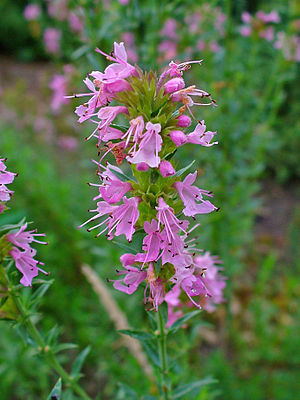- Image via Wikipedia— Hyssopus officinalis
Hyssop is a bushy perennial herb, Hyssopus officinalis, a member of the mint family, Lamiaceae. Native to southern Europe and central Asia, it is an evergreen herb that is typically planted in herb gardens. It has escaped garden areas and has become naturalized in the Northeastern United States. It can be found in dry soils, waste areas, fields, along roadsides and railways.
Being a member of the mint family hyssop shares common characteristics of other mints, namely aromatic foliage, tubular or lipped flowers and square stems. The stems are woody at the base and shoots rise up from the perennial root crown each spring. It grows to one to two feet tall with leaves that are paired or opposite one another. The narrow leaves are toothless, stalkless, and linear to lance-shaped. The foliage is strongly and sweetly aromatic, but not minty. When bruised, the aroma of the leaves is reminiscent of catnip and peppery.
The tubular or lipped flowers have stamens that protrude beyond the edge of the flower petals. The blooming period stretches from early summer to the middle of autumn. As the plant continues to grow throughout the growing season the flowers, which are clustered in the whorls of upper leaf axils, will form colorful, erect spikes. This makes for a nicely decorative plant in the herb garden, especially when it’s in bloom. The purple, pink or bluish flowers are attractive and will draw bees and butterflies.
Hyssop has a bitter yet warm taste that is used to flavor foods and beverages. Meats, fish dishes, vegetables, salads and sweets are flavored with hyssop leaves. Dried flowers are powdered and used for flavoring. It is an ingredient in the liqueurs Chartreuse and absinthe.
Hyssop is an ingredient in herbal teas used in folk medicine. Sweetened with honey it’s used to tame a sore throat or bad cough and for lung ailments. A strong leaf tea can be gargled for sore throats. Make hyssop tea by steeping one teaspoon of fresh leaves, or half a teaspoon of dried leaves, in a cup of near boiling water for five minutes, covered.
The essential oil contains thujone and phenol which give hyssop antiseptic properties. These chemicals stimulate the central nervous system and can initiate epileptic attacks when taken in high doses. Otherwise, hyssop is generally regarded as safe. Due to the presence of marrubin it has expectorant qualities and is effective for treating head colds. Anti-viral activity has been shown against herpes simplex and it’s being studied for application to HIV/Aids.

